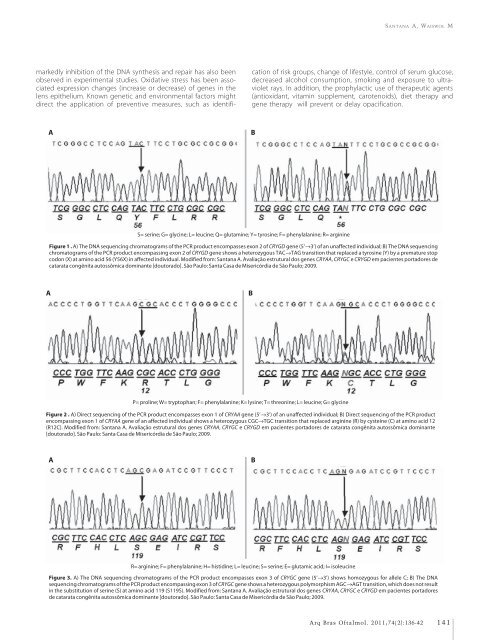a rquivos b rasileiros - Conselho Brasileiro de Oftalmologia
a rquivos b rasileiros - Conselho Brasileiro de Oftalmologia
a rquivos b rasileiros - Conselho Brasileiro de Oftalmologia
You also want an ePaper? Increase the reach of your titles
YUMPU automatically turns print PDFs into web optimized ePapers that Google loves.
SANTANA A, WAISWOL M<br />
markedly inhibition of the DNA synthesis and repair has also been<br />
observed in experimental studies. Oxidative stress has been associated<br />
expression changes (increase or <strong>de</strong>crease) of genes in the<br />
lens epithelium. Known genetic and environmental factors might<br />
direct the application of preventive measures, such as i<strong>de</strong>ntification<br />
of risk groups, change of lifestyle, control of serum glucose,<br />
<strong>de</strong>creased alcohol consumption, smoking and exposure to ultraviolet<br />
rays. In addition, the prophylactic use of therapeutic agents<br />
(antioxidant, vitamin supplement, carotenoids), diet therapy and<br />
gene therapy will prevent or <strong>de</strong>lay opacification.<br />
A<br />
B<br />
S= serine; G= glycine; L= leucine; Q= glutamine; Y= tyrosine; F= phenylalanine; R= arginine<br />
Figure 1 . A) The DNA sequencing chromatograms of the PCR product encompasses exon 2 of CRYGD gene (5’→3’) of an unaffected individual; B) The DNA sequencing<br />
chromatograms of the PCR product encompassing exon 2 of CRYGD gene shows a heterozygous TAC→TAG transition that replaced a tyrosine (Y) by a premature stop<br />
codon (X) at amino acid 56 (Y56X) in affected individual. Modified from: Santana A. Avaliação estrutural dos genes CRYAA, CRYGC e CRYGD em pacientes portadores <strong>de</strong><br />
catarata congênita autossômica dominante [doutorado]. São Paulo: Santa Casa <strong>de</strong> Misericórdia <strong>de</strong> São Paulo; 2009.<br />
A<br />
B<br />
P= proline; W= tryptophan; F= phenylalanine; K= lysine; T= threonine; L= leucine; G= glycine<br />
Figure 2 . A) Direct sequencing of the PCR product encompasses exon 1 of CRYAA gene (5’→3’) of an unaffected individual; B) Direct sequencing of the PCR product<br />
encompassing exon 1 of CRYAA gene of an affected individual shows a heterozygous CGC→TGC transition that replaced arginine (R) by cysteine (C) at amino acid 12<br />
(R12C). Modified from: Santana A. Avaliação estrutural dos genes CRYAA, CRYGC e CRYGD em pacientes portadores <strong>de</strong> catarata congênita autossômica dominante<br />
[doutorado]. São Paulo: Santa Casa <strong>de</strong> Misericórdia <strong>de</strong> São Paulo; 2009.<br />
A<br />
B<br />
R= arginine; F= phenylalanine; H= histidine; L= leucine; S= serine; E= glutamic acid; I= isoleucine<br />
Figure 3. A) The DNA sequencing chromatograms of the PCR product encompasses exon 3 of CRYGC gene (5’→3’) shows homozygous for allele C; B) The DNA<br />
sequencing chromatograms of the PCR product encompassing exon 3 of CRYGC gene shows a heterozygous polymorphism AGC→AGT transition, which does not result<br />
in the substitution of serine (S) at amino acid 119 (S119S). Modified from: Santana A. Avaliação estrutural dos genes CRYAA, CRYGC e CRYGD em pacientes portadores<br />
<strong>de</strong> catarata congênita autossômica dominante [doutorado]. São Paulo: Santa Casa <strong>de</strong> Misericórdia <strong>de</strong> São Paulo; 2009.<br />
Arq Bras Oftalmol. 2011;74(2):136-42<br />
141

















